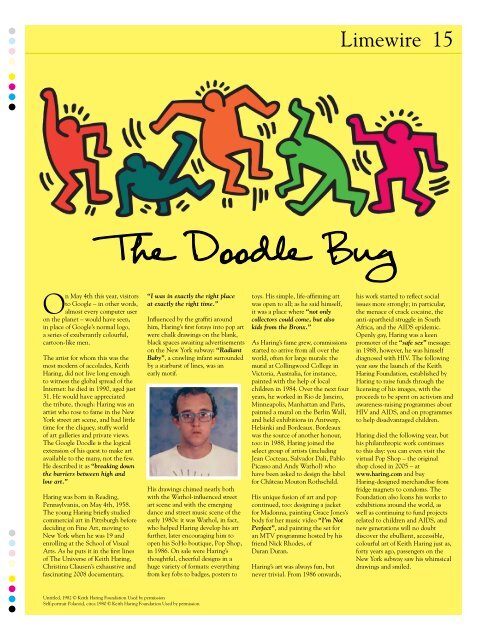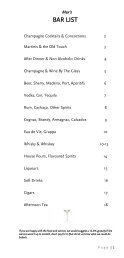Smoked and Uncut - Lime Wood
Smoked and Uncut - Lime Wood
Smoked and Uncut - Lime Wood
Create successful ePaper yourself
Turn your PDF publications into a flip-book with our unique Google optimized e-Paper software.
On May 4th this year, visitors<br />
to Google – in other words,<br />
almost every computer user<br />
on the planet – would have seen,<br />
in place of Google’s normal logo,<br />
a series of exuberantly colourful,<br />
cartoon-like men.<br />
The artist for whom this was the<br />
most modern of accolades, Keith<br />
Haring, did not live long enough<br />
to witness the global spread of the<br />
Internet: he died in 1990, aged just<br />
31. He would have appreciated<br />
the tribute, though: Haring was an<br />
artist who rose to fame in the New<br />
York street art scene, <strong>and</strong> had little<br />
time for the cliquey, stuffy world<br />
of art galleries <strong>and</strong> private views.<br />
The Google Doodle is the logical<br />
extension of his quest to make art<br />
available to the many, not the few.<br />
He described it as “breaking down<br />
the barriers between high <strong>and</strong><br />
low art.”<br />
Haring was born in Reading,<br />
Pennsylvania, on May 4th, 1958.<br />
The young Haring briefly studied<br />
commercial art in Pittsburgh before<br />
deciding on Fine Art, moving to<br />
New York when he was 19 <strong>and</strong><br />
enrolling at the School of Visual<br />
Arts. As he puts it in the first lines<br />
of The Universe of Keith Haring,<br />
Christina Clausen’s exhaustive <strong>and</strong><br />
fascinating 2008 documentary,<br />
“I was in exactly the right place<br />
at exactly the right time.”<br />
Influenced by the graffiti around<br />
him, Haring’s first forays into pop art<br />
were chalk drawings on the blank,<br />
black spaces awaiting advertisements<br />
on the New York subway: “Radiant<br />
Baby”, a crawling infant surrounded<br />
by a starburst of lines, was an<br />
early motif.<br />
His drawings chimed neatly both<br />
with the Warhol-influenced street<br />
art scene <strong>and</strong> with the emerging<br />
dance <strong>and</strong> street music scene of the<br />
early 1980s: it was Warhol, in fact,<br />
who helped Haring develop his art<br />
further, later encouraging him to<br />
open his SoHo boutique, Pop Shop,<br />
in 1986. On sale were Haring’s<br />
thoughtful, cheerful designs in a<br />
huge variety of formats: everything<br />
from key fobs to badges, posters to<br />
Untitled, 1982 © Keith Haring Foundation Used by permission<br />
Self-portrait Polaroid, circa 1980 © Keith Haring Foundation Used by permission<br />
toys. His simple, life-affirming art<br />
was open to all; as he said himself,<br />
it was a place where “not only<br />
collectors could come, but also<br />
kids from the Bronx.”<br />
As Haring’s fame grew, commissions<br />
started to arrive from all over the<br />
world, often for large murals: the<br />
mural at Collingwood College in<br />
Victoria, Australia, for instance,<br />
painted with the help of local<br />
children in 1984. Over the next four<br />
years, he worked in Rio de Janeiro,<br />
Minneapolis, Manhattan <strong>and</strong> Paris,<br />
painted a mural on the Berlin Wall,<br />
<strong>and</strong> held exhibitions in Antwerp,<br />
Helsinki <strong>and</strong> Bordeaux. Bordeaux<br />
was the source of another honour,<br />
too: in 1988, Haring joined the<br />
select group of artists (including<br />
Jean Cocteau, Salvador Dali, Pablo<br />
Picasso <strong>and</strong> Andy Warhol) who<br />
have been asked to design the label<br />
for Château Mouton Rothschild.<br />
His unique fusion of art <strong>and</strong> pop<br />
continued, too: designing a jacket<br />
for Madonna, painting Grace Jones’s<br />
body for her music video “I’m Not<br />
Perfect”, <strong>and</strong> painting the set for<br />
an MTV programme hosted by his<br />
friend Nick Rhodes, of<br />
Duran Duran.<br />
Haring’s art was always fun, but<br />
never trivial. From 1986 onwards,<br />
<strong>Lime</strong>wire 15<br />
his work started to reflect social<br />
issues more strongly; in particular,<br />
the menace of crack cocaine, the<br />
anti-apartheid struggle in South<br />
Africa, <strong>and</strong> the AIDS epidemic.<br />
Openly gay, Haring was a keen<br />
promoter of the “safe sex” message:<br />
in 1988, however, he was himself<br />
diagnosed with HIV. The following<br />
year saw the launch of the Keith<br />
Haring Foundation, established by<br />
Haring to raise funds through the<br />
licensing of his images, with the<br />
proceeds to be spent on activism <strong>and</strong><br />
awareness-raising programmes about<br />
HIV <strong>and</strong> AIDS, <strong>and</strong> on programmes<br />
to help disadvantaged children.<br />
Haring died the following year, but<br />
his philanthropic work continues<br />
to this day: you can even visit the<br />
virtual Pop Shop – the original<br />
shop closed in 2005 – at<br />
www.haring.com <strong>and</strong> buy<br />
Haring-designed merch<strong>and</strong>ise from<br />
fridge magnets to condoms. The<br />
Foundation also loans his works to<br />
exhibitions around the world, as<br />
well as continuing to fund projects<br />
related to children <strong>and</strong> AIDS, <strong>and</strong><br />
new generations will no doubt<br />
discover the ebullient, accessible,<br />
colourful art of Keith Haring just as,<br />
forty years ago, passengers on the<br />
New York subway saw his whimsical<br />
drawings <strong>and</strong> smiled.



